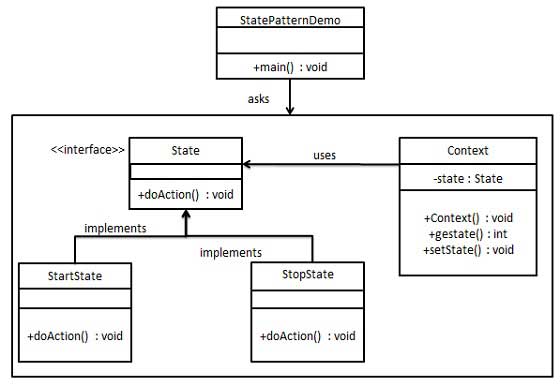State Pattern
State Pattern
A State Pattern says that "the class behavior changes based on its state". In State Pattern, we create objects which represent various states and a context object whose behavior varies as its state object changes.
The State Pattern is also known as Objects for States.
Benefits:
- It keeps the state-specific behavior.
- It makes any state transitions explicit.
Usage:
- When the behavior of object depends on its state and it must be able to change its behavior at runtime according to the new state.
- It is used when the operations have large, multipart conditional statements that depend on the state of an object.
Implementation
We are going to create a State interface defining an action and concrete state classes implementing the State interface. Context is a class which carries a State.
StatePatternDemo, our demo class, will use Context and state objects to demonstrate change in Context behavior based on type of state it is in.

Step 1
Create an interface.
State.java
public interface State { public void doAction(Context context); }
Step 2
Create concrete classes implementing the same interface.
StartState.java
public class StartState implements State { public void doAction(Context context) { System.out.println("Player is in start state"); context.setState(this); } public String toString(){ return "Start State"; } }
StopState.java
public class StopState implements State { public void doAction(Context context) { System.out.println("Player is in stop state"); context.setState(this); } public String toString(){ return "Stop State"; } }
Step 3
Create Context Class.
Context.java
public class Context { private State state; public Context(){ state = null; } public void setState(State state){ this.state = state; } public State getState(){ return state; } }
Step 4
Use the Context to see change in behaviour when State changes.
StatePatternDemo.java
public class StatePatternDemo { public static void main(String[] args) { Context context = new Context(); StartState startState = new StartState(); startState.doAction(context); System.out.println(context.getState().toString()); StopState stopState = new StopState(); stopState.doAction(context); System.out.println(context.getState().toString()); } }
Step 5
Verify the output.
Player is in start state Start State Player is in stop state Stop State

Comments
Post a Comment